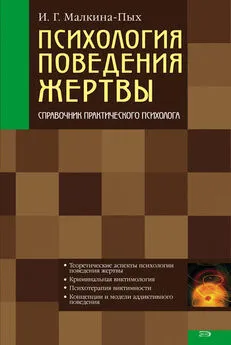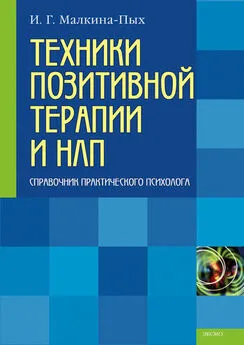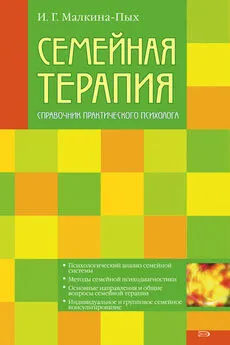Ирина Малкина-Пых - Психология поведения жертвы
- Название:Психология поведения жертвы
- Автор:
- Жанр:
- Издательство:неизвестно
- Год:неизвестен
- ISBN:нет данных
- Рейтинг:
- Избранное:Добавить в избранное
-
Отзывы:
-
Ваша оценка:
Ирина Малкина-Пых - Психология поведения жертвы краткое содержание
В справочнике рассмотрены предмет, история и перспективы виктимологии, проанализированы соотношения понятий типов жертв и видов виктимности, а также существующие виды и формы насилия. Особое внимание уделено анализу психологических теорий, которые с различных позиций объясняют формирование повышенной виктимности личности, или «феномена жертвы».
В книге также рассматриваются различные ситуации, попадая в которые человек становится жертвой, а именно криминальные преступления и захват заложников; такие специфические виды насилия, как насилие над детьми, семейное насилие, сексуальное насилие (изнасилование), школьное насилие и моббинг (насилие на рабочем месте). Рассмотрена виктимология аддиктивного (зависимого) поведения. Описаны как подходы к индивидуальному консультированию в каждом из указанных случаев, так и групповые формы работы в виде тренингов.
Данный справочник представляет собой удобный источник, к которому смогут обратиться практики, исследователи и студенты, для того, чтобы получить всеобъемлющую информацию по техникам и инструментам коррекционной работы как с потенциальными, так и реализованными жертвами различных экстремальных ситуаций.
Психология поведения жертвы - читать онлайн бесплатно полную версию (весь текст целиком)
Интервал:
Закладка:
Cohen P.D., Sas A. Cocaine use in Amsterdam in nondeviant subcultures // Addiction Research. 1994. V. 2. P. 71–94.
Coohey С. Neglectful mothers, their mothers and partners: The significance of mutual aid // Child Abuse and Neglect. 1995. V. 19. P. 885–895.
Cook D. Frantz-Cook A. A systematic treatment approach to wife battering // Journal of Marital and Family Therapy. 1984. V. 10. P. 83–93.
Coopersmith S. The Antecedents of Self-Esteem. San Francisco. W. H. Freeman amp; Co., 1967.
Costa P., McCrae F. Multiple uses for longitudinal personality data // European Journal of Personality, 1992. V. 6. P. 85 – 102.
Crossman P. Permission and protection // Trans. Anal. Bull. 1966. V. 5(19). P. 152–154.
Cryer L., Beutler L. Group therapy: An alternative treatment approach for rape victims // Journal of Sex and Marital Therapy. 1980. V. 6. P. 40–46.
Cunningham J.A., Humphreys K., Koski-Jannes A. Providing personalized assessment feedback for problem drinking on the internet // J. of study alcogolism/ 2000. V. 61(6). P. 794–798.
Danieli Y. As survivors age, Part II // NCP Clinical Quarterly. 1994. V. 4. P. 20–24.
Danieli Y. Treating survivors and children of survivors of Nazi Holocaust. Post-Traumatic Therapy. New York: Brunner / Mazel, 1988.
Deikman A. The wrong way home: Cults in everyday life. Boston: Beacon Press, 1990.
Dineen T. Manufacturing victims: What the psychology industry is doing to people. Westmount, Canada: Robert Davies Multimedia Publishing, 1996.
Dodge К.A., Coie D. Social information-processing factors in reactive and proactive aggression in children’s peer groups // Journal of Personality an Social Psychology. 1987. V. 53. P. 1146 – 1158
Doernre W. G., Lab S. P. Victimology. Cincinnati, OH., U.S.A.: Anderson Publishing Co., 1995.
Douglas J., Burgess A., Ressler R. (Eds.) Sexual Homicide: Patterns and Motives/ New York: Lexington Books, 1988.
Downes D., Davis B., David M., Stone P. Gambling, Work and Leisure. London: Routledge, 1976.
Doyle J. A Society of Mind: Multiple Perspectives, Reasoned Assumptions and Virtual Copies // Proc. 8th International Joint Conference on Artificial Intelligence/ 1983. P. 309–314.
Doyle J. Logic, rationality and rational psychology // Computational Intelligence/ 1987. V. 3(3). P. 175–176.
Drewnowski A., Yee D.K., Kurth C.L., Krahn D.D., Eating pathology and DSM – III – R bulimia nervosa: A continuum of behavior // Am. J. Psychiatry. 1994. V. 151. P. 1217–1219.
Driscoll T.J. Food addiction // N.J. Nurse. 1995. V. 25(4). P. 4 – 10.
Eberly R.E., Engdahl B.E. Prevalence of somatic and psychiatric disorders among former prisoners of war // HospComm Psychiatry. 1991. V. 42. P. 807–813.
Eckberg M. Victims of cruelty, somatic psychotherapy in the treatment of posttraumatic stress disorder. Berkeley, Calif., U.S.A.: North Atlantic Books, 2000.
Ellis A. Humanistic psychotherapy: The rational-emotive approach. New York: McGraw – Hill, 1973.
Ellis A. Overcoming resistance. Rational-emotive therapy with difficult clients. New York: Springer, 1985.
Ellis A. Reason and Emotion in Psychotherapy. New York: Lyle Stuart, 1962.
Ellis A. Techniques for disputing irrational beliefs (DIB’S). New York: Institute for Rational Living, Inc., 1974.
Ellis A., Dryden W. The practice of rational-emotive behavior therapy. New York: Springer, 1996.
Ellis A., Grieger R. (Eds.) Handbook of rational-emotive therapy. New York: Springer, 1977.
Ellis E. M. et al. A review of empirical rape research. Victim reactions and response to treatment // Clinical Psychology Review. 1983. V. 3. P. 473–490.
Engs R. Controversies in the addiction field. Kendall Hunt: Dubuke Iowa, 1990.
Enwright J. Enlightening Gestalt. Waking up from the nightmare. New York, 1980.
Eppright T., Allwood M., Stern B.,Theiss T. Internet addiction, a new type of addiction? // Modern medicine. 1999. V. 96(4). P. 133 – 136
Epstein R.S. PTSD, a review of diagnostic and treatment issues // Psychiatric annals. 1989. V.19 (10). P. 356–377.
Erikson E.H . Childhood and society. New York: Norton, 1950.
Erskine R., Zalcman M. The racket system, a model for racket analysis // Transactional Analysis Journal, 1979. V. 9. P. 51–59.
Espmark S. Psychological aspects of obesity // Reprod life, Proc. 10-th Int. Congr. Psychosomat. Obstet. and Gynaecal., Stockholm, 14–17 June, 1992. Carnforth., Parc Ridge (N.J.), 1992. P. 243–249.
Evan B. Collected works. San Francisco: Blanche Evan Dance Foundation, 1991.
Fairbairn W.R.D. Psychoanalytical Studies of Personality. Routledge (Reprint Edition), 1994.
Fairburn C.G., Agras W.S., Wilson G.T. The research on the treatment of bulimia nervosa, practical. and theoretical implications // Anderson G.H., Kennedy S.H. (ed). The Biology of Feast and Famine, Relevance to Eating Disorders. San Diego: Academic Press, 1992. P. 318–340.
Fairburn C.G., Jones R., Peveler R.C., Can S.J., Solomon R.A., O’Connor M.E., Burton J., Hope R.A. Three psychological treatments for bulimia nervosa // Arch. Gen. Psychiatry. 1991. V.48. P. 463–469.
Fairburn C.G., Kirk J., O’Connor M., Cooper P.J. A comparison of two psychological treatments for bulimia nervosa // Behav. Res. Ther. 1986. V. 24. P. 629–643.
Fairburn C.G., Marcus M.D., Wilson G.T. Cognitive-behavioral therapy for binge eating and bulimia nervosa: A comprehensive treatment manual // Fairburn C.G., Wilson G.T. (ed). Binge Eating, Nature, Assessment and Treatment. New York: Guilford Press, 1993. P. 361–404.
Fenichel O. Impulse neuroses and addictions // Fenichel O. The psycho-analytic theory of neurosis. London, 1946.
Ferenczi S. Further Contributions to the Theory and Techniques of Psychoanalysis. New York: Norton, 1926.
Fineman S. Unemployment, Personal amp; Social Consequence. London. Tavistok, 1987.
Fineman S. White collar unemployment, Impact a Stress. Chichester, 1983.
Fingarette H. Heavy Drinking, The Myth of Alcoholism as a Disease. Berkeley, CA: University of California Press, 1988.
Finkelhor D. (ed.) Child sexual abuse, new theory and research. New York: The Free Press, 1984.
Fisher G., Harrison T.C. Substance abuse, Information for school counselors, social workers, therapists and counselors. Boston: Allyn amp; Bacon, 1997.
Frankl V.E. Man’s Search for Meaning. Simon amp; Schuster, Inc., First Printing English Translation, 1959.
Franko D.L. et al. The bulimic authomatic though test // J. Clin. Psychol. 1992. V. 48(4). P. 505–509.
Franks J.D. Persuasion and healing. Baltimore, MD: Johns Hopkins University Press, 1961.
Gabbard G.O.,Twemlow S.W. Role mother – son incest in pathogenesis narcissistic personality // J. Amer. Psychoanal. Assn., 1994. V. 42. P. 171–190.
Galanter M. Cults, faith healing and coercion. New York: Oxford University Press, 1989.
Galanter M. Unification Church («Moonie») dropouts: Psychological readjustment after leaving a charismatic religious group // American Journal of Psychiatry. 1983. V. 140. P. 984–989.
Galanter M., Brook D. Network therapy for addiction // International J. of Group Psychotherapy. 2001. V. 51(1). P. 101–122.
Galanter M., Buckley P. Evangelical religion and meditation: Psychological effects // Journal of Nervous and Mental Disease. 1978. V. 166. P. 685–691.
Galanter M., Keller D.S., Dermatis H., Biderman D. Use of the internet for addiction education // American J. of Addiction. 1998. V. 7(1). P. 7 – 13.
Galanter M., Rabkin R., Rabkin I., Deutsch A. The «Moonies»: A psychological study of conversion and membership in a contemporary religious sect // American Journal of Psychiatry. 1979. V. 136. P. 165–170.
Garbarino J., Stott F.M. What children can tell us. San Francisco, CA: Jossey-Bass Publishers, 1989.
Garner D.M., Garfinkel P.E. Handbook of Treatment for Eating disorders (2nd ed.) New York: The Guilford Press, 1997.
Giambalvo C. Exit counseling: A family intervention. Bonita Springs, FL, American Family Foundation, 1992.
Glover E. Alcoholism and drug addiction // Glover E. The technique of psychoanalysis. New York, 1963.
Goldberg I. From Internet Addiction Disorder, Available at http://www.urz.uni – heidelberg.de/Netzdienste/anleitung/wwwtips/8/addict.html. Accessed June 2, 2005.
Goldberg I. Treatment of Internet Disorders. New York: Penguin, 1999.
Goodwin J. Post-traumatic symptoms. Incest Victims. – American Psychiatric Association, 1995.
Green A. H. Children Traumatized by Physical Abuse. – American Psychiatric Association, 1995.
Green B.L. Defining trauma, terminology and teneric stressor dimensions // Journal Applied Social Psychology San Francisco. San Francisco. 1990. № 20.
Green B.L., Lindy J.D., Grace M.C, Leonard, A.C. Chronic posttraumatic stress disorder and diagnostic co-morbidity in a disaster sample // J. Nerv. Mental Disorder. 1992. V. 180. P. 760–766.
Griffiths M. Psychology of computer use, some comments on «addictive use of the internet» by Young // Psychological reports. 1997. V. 80. P. 181–182.
Haldre L. Koolivдgivald. Teoses: Laps ja vдgivald. Konverentsi materjale.Vastutav toimetaja: Katrin Simmermann. Tallinn, 1997.
Hall R.C.W., Blakey R.E. Hall A. Bulimia nervosa four uncommon subtypes // Psychosomatics. 1992. V. 33(4). P. 428–436.
Hassan S. Combating cult mind control. Rochester. VT: Park Street Press, 1988.
Heilbrun A.B., Worobow A.L. Attention and disordered eating behavior // J. Clin. Psychol. 1991. V. 47(1). P. 3–9.
Heinberg L.J. Theories of body image disturbance, Perceptual, developmental, and sociocultural factors // Thompson J. K. (ed) Body Image, Eating Disorders. and Obesity. Washington: American Psychological Association, 1997. P. 27–47.
Herman J.L. Trauma and Recovery. New York: Basic Books, 1992.
Herman J.L., Russel D., Trocki K. Long-term effects of incestuous abuse in childhood // American Journal of Psychiatry. 1986. V. 143, P. 1293–1296.
Hibbard R.A., Hartman G.L. Genitalia in human drawings: childrearing practices and child sexual abuse // Journal of Pediatrics. 1990 (a). V. 116(5). P. 822–828.
Hibbard R.A., Hartman G.L. Emotional indicators in human figure drawings of sexually victimized and nonabused children // Journal of Clinical Psychology, 1990 (b). V. 46(2). P. 211–219.
Horowitz M.J. Personlichkeitsstile und Belastungsfolgen. Intergrative psychodynamisch-kognitive Psychotherapie // Therapie der posttraumatischen Belastungstoerung / Hrsg. A. Maercker. Heidelberg, 1998 (a).
Horowitz M.J. Personlichkeitsstile und Belastungsfolgen. Intergrative psychodynamisch-kognitive Psychotherapie // Therapie der posttraumatischen Belastungstoerung / Hrsg. A. Maercker. Heidelberg, 1998 (b).
Horowitz M.J. Stress response syndromes. 2nd ed. Northvale, N.J.: Aronson, 1986.
Horowitz M.J., Becker S.S. Cognitive response to stress, Eperimental studies of a compulsion to repeat trauma // Psychoanalysis and contemporary science / Eds. R. Holt. Peterfreund. N.Y.: Macmillan, 1972. V. 1.
Читать дальшеИнтервал:
Закладка:










